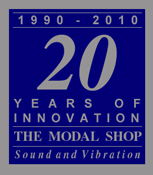Tip of the Month
|
Certain accelerometers - commonly triaxial units - are packaged in a non-symmetric fashion, often with an off-center through-hole mount. These accelerometers can be the most challenging to calibrate because the sensing element is not aligned with the sensor's center of gravity or its intended mounting configuration. In order to get acceptable results, the unit often needs to be mounted as a best compromise between these. In other words, if the triax is mounted with its through-hole and a large amount of the sensor is consequently offset on the reference, a significant amount of transverse motion can be induced causing "glitches" in the calibration frequency response. For this case, the calibration technician may be required to adhesively mount the unit, avoiding the use of the more convenient through-hole threaded mount, and perform trial and error with adhesive mounting to produce the best calibration results.
|
| Quick Links |
ISO TC 108 - Mechanical vibration, shock and condition monitoring
ISO TC 108/SC 3 - Use and calibration of vibration and shock measuring instruments
SAVIAC
|
| Select Newsletter Articles by Topic | |
|
|
|
Lab Lessons Learned from Student Testing, Part 2
| |
Last month we featured an application note by Purdue University Professor, Doug Adams, sharing a number of educational experiences his students have learned "the hard way."
 | | (a) Driver's side spindle base triaxial accelerometer and (b) data acquisition system in the back seat |
As the second installment of a three-part series, the experiments and results of a student team's project are presented covering the analysis of road conditions. Road quality is determined with spectral analysis using an automotive suspension system as a mobile operating data acquisition system.
Click here to read more
http://www.modalshop.com/calibration.asp?ID=774
|
International Standard of Units Reference
| |
 No matter if you are a technician, engineer or physicist, it is important to be familiar with the International System of Units (SI units) while communicating and reporting test results, measurements and calibration data. A concise 4-page version of the International System of Units is available on line through the BIPM web site, and provides a good reference document on the topic. No matter if you are a technician, engineer or physicist, it is important to be familiar with the International System of Units (SI units) while communicating and reporting test results, measurements and calibration data. A concise 4-page version of the International System of Units is available on line through the BIPM web site, and provides a good reference document on the topic.
Marco Peres, a sound and vibration engineer at The Modal Shop, notes that:
"Interestingly enough, in our community, vibration data is commonly reported in units of g, instead of metre per second squared (m/s2), the official SI units of acceleration."
Click here to read more
http://www.modalshop.com/calibration.asp?ID=775
|
|
Blast from the Past - Accelerometer Application Focus on Seismic Sensors
| |
For those who may be new to our newsletter, we wanted to highlight an article from a previous sensor & calibration tips - "Accelerometer Application Focus on Seismic Sensors"...
Piezoelectric accelerometers are well suited for seismic vibrations studies. They are completely self  contained and self generating from an inertial frame of reference. This eliminates the challenges with relative vibration found in optical/laser methods, as well as dual ended attachment coil based methods, such as LVDT's. The second most common challenge with seismic measurements is the low excitation levels of seismic events. In terms of acceleration, the g level falls off in an inverse square relationship for a constant displacement as frequency decreases, thus seismic events typically exhibit small acceleration levels. contained and self generating from an inertial frame of reference. This eliminates the challenges with relative vibration found in optical/laser methods, as well as dual ended attachment coil based methods, such as LVDT's. The second most common challenge with seismic measurements is the low excitation levels of seismic events. In terms of acceleration, the g level falls off in an inverse square relationship for a constant displacement as frequency decreases, thus seismic events typically exhibit small acceleration levels.
http://www.modalshop.com/calibration.asp?ID=212
|
| |
Thanks for joining us for another issue of sensor & calibration tips. As always, please, speak up and let us know what you like. We appreciate all feedback: positive, critical or otherwise...Take care!
Sincerely,
|
 Michael J. Lally A PCB Group Company
| |